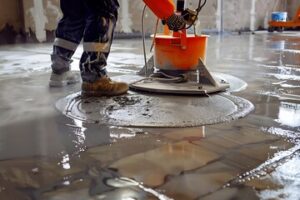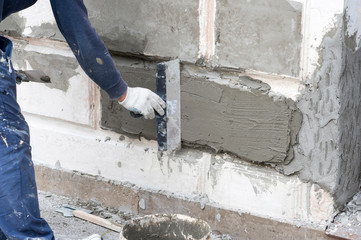Concrete Floor Polishing Vs Sanding
When it comes to concrete flooring options, the choices are endless. But many people find themselves confused when trying to determine the method used in those Pinterest pictures that they love.
Modern concrete is leveled using large ride-on power trowels to ensure consistent flatness and curing. This helps the polishing process to go smoothly and consistently. Read on Concrete Floor Polishing Orange County for more details.
Concrete floor polishing involves mechanically grinding a concrete surface with diamond-encrusted floor grinding shoes to achieve a desired level of sheen or gloss. It is a similar process to sanding wood, and it creates a surface that enhances lighting and reduces maintenance requirements. It is used in a variety of settings, including retail stores and office buildings. It offers a modern look that complements contemporary design and is a durable option for high-traffic areas.
The first step in the polishing process is preparing the surface. It is important to thoroughly clean the floor with a degreaser and rinse well before proceeding. It is also important to patch any cracks or holes, allowing them to dry completely before continuing. After patching, the concrete must be hardened through a chemical solution called a densifier, which allows the floor to accept the grinding and polishing processes.
After the surface has been prepped and cleaned, it is ready for the first grinding stage with coarse-grit diamond pads. The grit is gradually reduced as you work over the entire surface, creating a flat and even finish. After you’ve achieved the level of sheen you desire, you can move on to the honing and polishing stages with finer abrasives.
During the honing and polishing steps, you can use color dyes or stains to enhance the appearance of the concrete. It’s important to follow the manufacturer’s instructions to ensure proper application. Once the floors are finished, they can be sealed to protect against stains and to extend the life of the concrete. This is an optional step, but one that’s highly recommended to help guard against damage and premature wear. Regular sealing can extend the life of your polished concrete floors up to 10 years.
Grinding
Concrete floor polishing is a process of grinding a concrete surface with diamond-tipped blades attached to a heavy-duty machine. This is done to level uneven areas, smooth out the appearance of the concrete, and increase its overall durability to protect it from incidental scratches and other damage. It is typically done every 2-3 years and can be done in any room of the home or business, depending on traffic.
To begin the grinding phase, any existing coatings, paints, or sealers need to be removed using specific removal tools and equipment. Once the floor has been completely prepped, a coarser concrete grinding grit is used to remove any high spots and make it ready for actual polishing. Once the concrete is a consistent grind, higher diamond 100 grit, 200 grit, and 400 grit pads are progressively used to pre-polish the concrete. This exposes the aggregate and creates a more smooth, reflective finish.
If the customer wishes to add color or pattern to the polished concrete, stains and dyes can be applied at this point. Once the surface is a consistent, shiny sheen, it’s time to consider protecting and maintaining the investment with a concrete sealer.
The best concrete sealer will protect the newly-polished floor and bring out its sheen. To apply the sealer, a sprayer is used to ensure even coverage. It is then allowed to dry according to the manufacturer’s instructions. With proper care, the polished concrete will last a long time and remain in beautiful condition for years to come.
Honing
In the honing phase, a series of increasingly finer diamond grits smooths the concrete surface to create a low or medium sheen. This step is crucial to a polished concrete finish that is both durable and visually appealing. It is also important to note that a concrete floor may not be considered “polished” until it has been honed to at least the 1600 grit level.
During the honing phase, it is common to use water in conjunction with the diamond abrasives to aid in the process. This water helps to prevent dust build up as well as keeps the abrasives cool and lubricated, making for an efficient grinding and polishing experience. This process is also known as wet polishing, and it typically uses larger corded electrical machines for quicker floor coverage, though small hand-held devices can be used to reach hard-to-reach areas.
Once the initial grinding and honing are complete, a specialized chemical densifier can be applied to increase the density of the concrete and help the surface resist scratching and staining. While this isn’t a requirement, it can significantly extend the life of a polished concrete surface.
After the concrete has been densified, a sealant can be applied to protect the surface from stains and premature wear. Depending on the customer’s preference, a variety of different finishes can be applied to the concrete to enhance its aesthetic. Examples include a gloss, which is highly reflective and ideal for light commercial environments, or a salt and pepper finish, which gives the concrete a speckled appearance with varying degrees of aggregate exposure. This is a popular choice for residential and light commercial settings and can complement many design styles.
Sealing
Concrete floor polishing requires a great deal of effort and time. However, the results are unmatched by any other flooring solution. It’s also extremely durable and easy to maintain. Unlike other commercial flooring options, polished concrete resists moisture that can cause mold, mildew and fungus. It also has the ability to repel oil and other liquids that can stain.
To protect the polished concrete surface, the next step in the process is applying a protective coating. This can be an epoxy or a film-forming sealer. Either way, the product should be selected to match the expected traffic and usage of the space.
The sealing phase is important because it keeps the polished concrete looking its best and resists stains. It’s also a good opportunity to apply color or pattern to the concrete. It’s a good idea to let the concrete dry for a few days between each step to prevent any damage or discoloration.
When using a concrete sealer, it’s important to use a pH-neutral cleaner before applying the product. This will ensure that all pores are free of dirt and contaminants that could interfere with the application of the sealer. It’s also a good idea to avoid direct sunlight when applying the sealer. This can cause the product to dry too quickly, resulting in an uneven finish.
In the end, a well-polished concrete floor will last for a long time and provides a beautiful appearance that is sure to impress visitors and clients. It also offers the added benefit of being more cost-effective than other flooring options and contributes to LEED credits for environmentally friendly buildings. With regular cleaning, including sweeping and mopping, it’s possible to keep your concrete floors looking their best for years to come.
Finishing
Concrete floor polishing is a multi-step process that involves mechanically grinding and honing a concrete slab with diamond bonded abrasives to achieve a desired level of shine or sheen. The process also includes patching and grouting to fill cracks, voids, micropits, and other imperfections. Depending on the application, stains or colored dyes may be applied at this stage to create unique aesthetic effects. Finally, a protective coating is applied to the concrete surface that protects it from damage and wear.
There are two types of concrete floor polishing; dry and wet. The wet method uses water at every stage and is generally used in large, corded electrical machines, although hand machines can be used for harder-to-reach areas. This method is faster and more effective than the dry method, which requires constant dust cleanup and sanding.
A full mechanical polish is achieved by dressing the concrete with a progression of coarse and fine diamond metals, much like sanding wood. Starting with a very coarse grit and working up to a very fine one, each successive step removes previous layers of concrete allowing the diamonds to penetrate deeper into the slab. This produces a very high sheen when looked at from a distance and allows for good side and overhead lighting reflection.
An alternative to a full mechanical polish is a system called a half polish that involves only three processing steps (half of the steps required for a true polished concrete surface). This is a topical solution that does not provide a true sheen and will require regular waxing. After the concrete is polished and coated, a final step involves applying a chemical hardener to the surface. This helps to seal the concrete, preventing problems like mildew and mold from growing in the pores.

